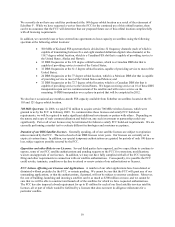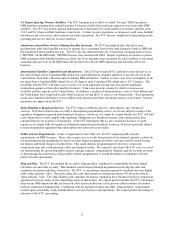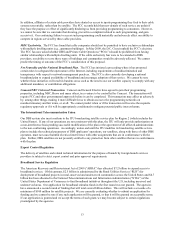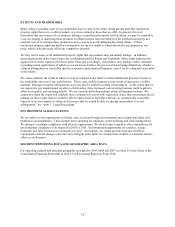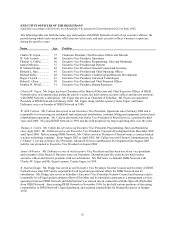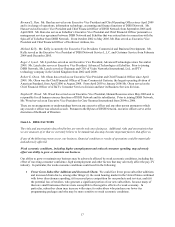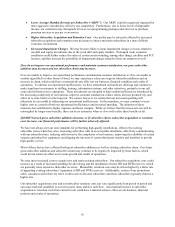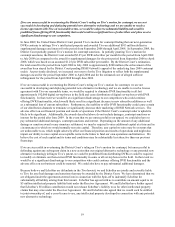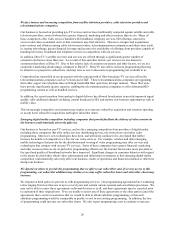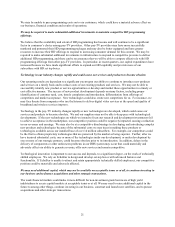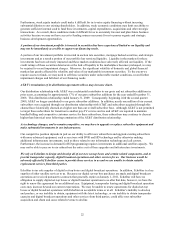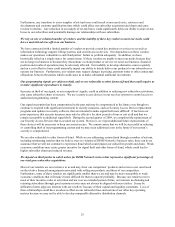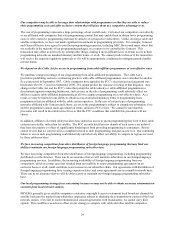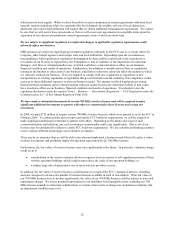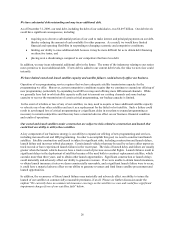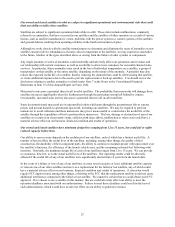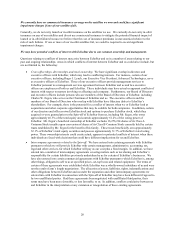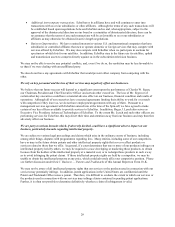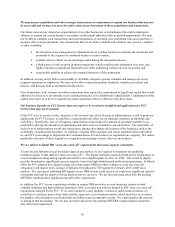Dish Network 2009 Annual Report Download - page 30
Download and view the complete annual report
Please find page 30 of the 2009 Dish Network annual report below. You can navigate through the pages in the report by either clicking on the pages listed below, or by using the keyword search tool below to find specific information within the annual report. 20
We face intense and increasing competition from satellite television providers, cable television providers and
telecommunications companies.
Our business is focused on providing pay-TV services and we have traditionally competed against satellite and cable
television providers, some of whom have greater financial, marketing and other resources than we do. Many of
these competitors offer video services bundled with broadband, telephony services, HD offerings, interactive
services and video on demand services that consumers may find attractive. Moreover, mergers and acquisitions,
joint ventures and alliances among cable television providers, telecommunications companies and others may result
in, among other things, greater financial leverage and increase the availability of offerings from providers capable of
bundling television, broadband and telephone services in competition with our services.
In addition, DirecTV’s satellite receivers and services are offered through a significantly greater number of
consumer electronics stores than ours. As a result of this and other factors, our services are less known to
consumers than those of DirecTV. Due to this relative lack of consumer awareness and other factors, we are at a
competitive marketing disadvantage compared to DirecTV. DirecTV also offers exclusive programming that may
be attractive to prospective subscribers, and may have access to discounts on programming not available to us.
Competition has intensified in recent quarters with the rapid growth of fiber-based pay-TV services offered by
telecommunications companies such as Verizon and AT&T. These telecommunications companies are upgrading
their older copper wire telephone lines with high-bandwidth fiber optic lines in larger markets. These fiber optic
lines provide significantly greater capacity, enabling the telecommunications companies to offer substantial HD
programming content as well as bundled services.
In addition, the recent transition from analog to digital delivery has allowed broadcasters to provide improved signal
quality, offer additional channels including content broadcast in HD, and explore new business opportunities such as
mobile video.
This increasingly competitive environment may require us to increase subscriber acquisition and retention spending
or accept lower subscriber acquisitions and higher subscriber churn.
Emerging digital media competition including companies that provide/facilitate the delivery of video content via
the Internet could materially adversely affect us.
Our business is focused on pay-TV services, and we face emerging competition from providers of digital media
including those companies that offer online services distributing movies, television shows and other video
programming. Moreover, new technologies have been, and will likely continue to be, developed that further
increase the number of competitors we face for our video services. For example, wireless and other emerging
mobile technologies that provide for the distribution and viewing of video programming may offer services and
technologies that compete with our pay-TV services. Some of these companies have greater financial, marketing
and other resources than we do. In particular, programming offered over the Internet has become more prevalent as
the speed and quality of broadband networks have improved. Significant changes in consumer behavior with regard
to the means by which they obtain video entertainment and information in response to this emerging digital media
competition could materially adversely affect our business, results of operations and financial condition or otherwise
disrupt our business.
We depend on others to provide the programming that we offer to our subscribers and, if we lose access to this
programming, our subscriber additions may decline or we may suffer subscriber losses and subscriber churn may
increase.
We depend on third parties to provide us with programming services. Our programming agreements have remaining
terms ranging from less than one to up to several years and contain various renewal and cancellation provisions. We
may not be able to renew these agreements on favorable terms or at all, and these agreements may be canceled prior
to expiration of their original term. If we are unable to renew any of these agreements or the other parties cancel the
agreements, there can be no assurance that we would be able to obtain substitute programming, or that such
substitute programming would be comparable in quality or cost to our existing programming. In addition, the loss
of programming could increase our subscriber churn. We also expect programming costs to continue to increase.


